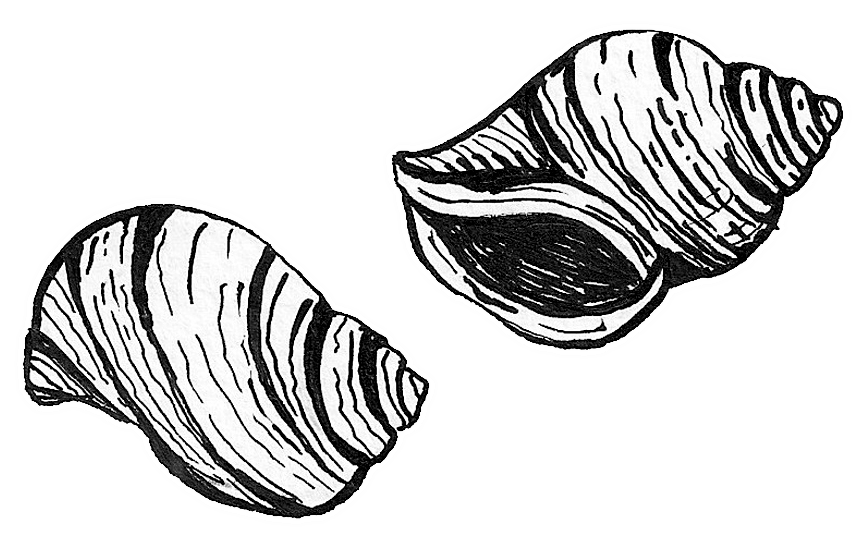The Purple
Between legend and reality, purple has always been linked, in one way or another, to the Phoenicians, it contributed to their reputation. Some historians reported that the Greeks gave them the name of Phoenician (Greek phoenix) in relation to the purple color, which they had made as one of their principal specialties.
For an introduction, what could be more perspicacious and more representative than this passage illustrated by Uderzo and Goscinny in their comic book, Asterix the Gladiator.
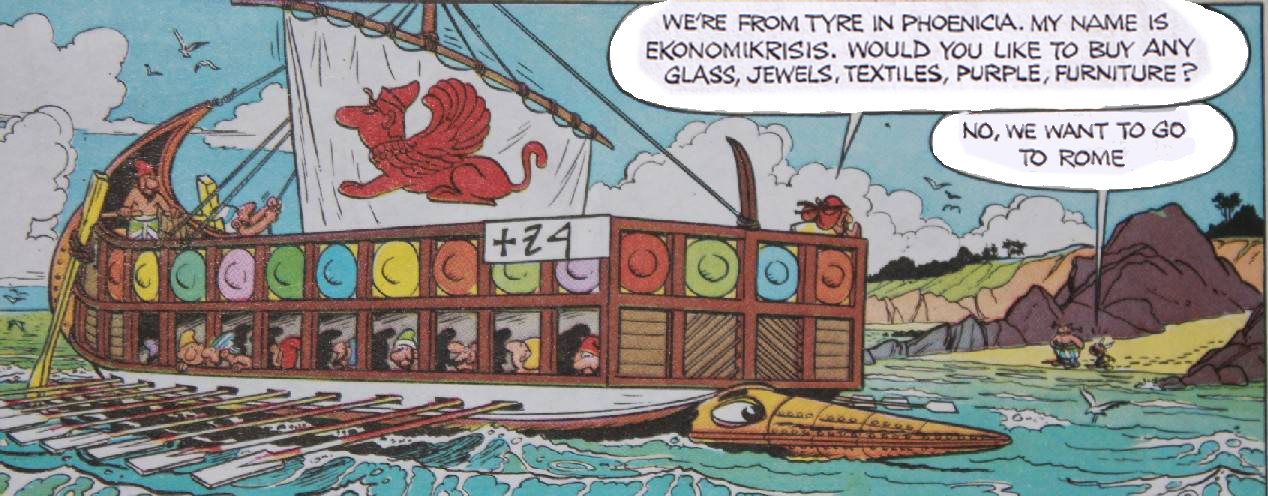
Extract Asterix the Gladiator
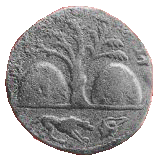
Currency of Tyre - Murex
The legend tells that the discovery of the purple was attributed to the god Melqart Heracles. While he was walking on the beach with the nymph Tyros, his dog found a Murex and munched on it. Its jaws tinged purple color. The nymph admired the color and asked the God to offer her a cloth with such a beautiful color. In order to please his sweetheart, Melqart, ordered to collect the seashells and to prepare a tincture of this crimson color, and make a dyed tunic witch delight the heart of the nymph.
From an archaeological point of view, the old remains of the dye-works discovered on the eastern coast of the Mediterranean Sea, proved that the purple dye industry existed there since ancient times. In 1934, François Thureau-Dangin (1872-1944), archaeologist and French epigraphist published a cuneiform text from Ugarit, which stipulated that in about 3500 years ago, a local merchant noted the quantity of purple wool owed to him by some persons, who appear to be dyers. Such texts lead us to think that the wool was distributed to the dyers in order to be colored, and then recuperated by merchants who resold it locally or exported it. Those commercial transactions indicate the presence of the purple industry on the Canaanite coast in the middle of the second millennium BC(1).
In written documents, testimonials about purple great value are numerous and varied. Two biblical texts talk about it: Chronicles 2: 2-14: "Hiram Abi, the son of a woman of the daughters of Dan, and a Tyrian father, skilful to work in gold, silver, brass and iron, stone and wood, and with purple and blue ...". Or Chronicles 2: 3-14: "He made the veil of blue and purple and crimson yarn and fine linen, with cherubim worked into it". Through these two examples, it is important to emphasize that the impact of the Phoenician craftsmen, since the first millennium BC, has been recognized and was very important in ancient times.
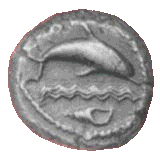
Currency of Tyre - Murex
In Assyrian registers, a mural inscription, from the eighth century BC, mentions this wool in the tributes list of an Assyrian king. Under the reign of Tiglath-Pileser III (744-721 BC), the Phoenician cities added rich clothing in purple, with the precious gifts in gold and silver, sent to the Assyrian monarchs.
During the Persian period (550-330 BC), only kings were worthy to dress with purple fabrics. After the conquest of Egypt, Cambyses, king of Persia, prepared an expedition, in 525 BC, against Ethiopia. Herodotus relates that he dispatched spies, "the fish eaters, with gifts of which a purple coat, a collar and braided gold bracelets, and alabaster box containing incense with an earthenware jar filled with palm wine. The king of Ethiopia was suspicious of Cambyses. Seizing the purple garment, he was curious as to how it was manufactured. When he learned the truth about the purple dye, he says that these people, as well as their clothes, were full of guile"(2).
In the beginning of Roman times, the prerogative of wearing the purple was extended to senators and priests, becoming the symbol of power or high dignity. Plutarch in the Life of Aratus narrates about "the priest of Aratus, who (during sacrificial ceremonies) wore a headband, not pure white but purple and white". Plutarch also mentions the purple color in the Life of Romulus: "And many were the people who came together, while he (Romulus ) himself sat in front, among his chief men, clad in purple", and by reporting the criticism against him, "to renounce his popular ways, and to change to the ways of a monarch, (…). For he dressed in a scarlet tunic, and wore over it a toga bordered with purple".
Pliny the Elder (AD 23 – AD 79), in the ninth book of his Natural History, describes the splendor and luxury represented by the purple. "In Asia the best purple is that of Tyre, [...]. It is for this color that the fasces and the axes of Rome make way in the crowd; it is this that asserts the majesty of childhood; it is this that distinguishes the senator from the man of equestrian rank; by persons arrayed in this color are prayers"(3).
At the time of Nero, the capital punishment was imposed, with confiscation of properties, for those who would dress, or even buy, the imperial purple. In Constantinople, the emperor's bedroom was painted with purple color, and his son, who was born in this room, enjoyed the prestige of having the nickname of Porphyrogenitus: "born in the purple".
The scarcity of murex provoked the disappearance of the manufacturing techniques of the purple dye, but this color remains, to the present day, a sign of magnificence. The cardinals of the Roman Catholic Church keep the privilege to wear the purple color.
Process for obtaining purple color
When we mention purple, our first reaction is to think about the murex, a marine gastropod mollusk of several varieties. In the eighteenth century, Carl Linnaeus (Carl von Linné), the Swedish scientist, established the species list specifying the two principal shellfish that provide the purple: the murex brandaris and the murex trunculus, their scientific names: Bolinus brandaris and Hexaplex trunculus.
Pliny the Elder, describes in his Natural History the process of obtaining the purple dye from murex Trunculus Phyllonotus and its variant Buccinum. Two similar species that produce, after crushed and mixed with water, a secretion containing the enzyme needed to produce a precipitate of red-violet color: the purple color. On the other hand, the bath of the Purpura Haemastoma and Brandaris murex, remained colorless, and it only produced the purple color that after the addition of a small quantity of murex Trunculus.
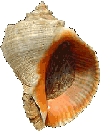
Murex - Purple
The first dyeing consisted of a textile soaked in a basin of water, then adding the crushed Murex. The color appeared, and textiles, withdrawn two days later and cleared of murex debris, kept the purple dye even after washing. The remaining dye bath, could no longer serve and was thrown away. The liquid rejected by Murex in water infiltrates the textile, penetrating even into the fiber. The color which subsequently appeared by air oxidation, was resistant to washing.
To optimize this dye and develop its large-scale industrialization, the inhabitants of Tyre developed a special process described by Pliny the Elder: "it is requisite to add salt, about one sextarius to every hundred pounds of juice. It is sufficient to leave them to steep for three days, no more, because the fresher they are, the greater virtue there is in the liquor. It is then set to boil in lead basins"(4). The interaction between white lead or tin with alkali metal carbonates (nitrate or oak wood ash containing potash) emanated hydrogen which acted as a reducing agent (perfect deoxidizer) witch prevented the color from wearing out.

Murex - Purple
From the beginning of the twentieth century, scientists and chemists attempted to retrieve the "old fashioned" dyeing processes of the famous "Tyrian purple". The identification of the dye principle was carried out by P. Friedlander in 1909(5).
The question was, how did the ancients find the way to keep this product and optimize it?
In 1938, Paul Karrer, in his organic chemistry book, noted the following statement: "The principle of the container is to reduce the precipitate insoluble dye into a phenol derivative called leuco. This reduced leuco dye (deoxidized) becomes soluble in an alkaline bath losing its color"(6).
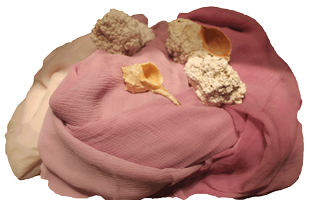
Purple Cloth - National Museum of Beirut
Textile fibers, macerated in the bath "leuco" for tens of hours were taken out and dewatered, would begin to dye gradually until reaching a maximum insoluble color, resistant to washing through the contact with oxygen air. The dye precipitate attacked in the fiber and bath could still serve until exhaustion, nonetheless giving tones increasingly clear.
Several studies and experiments followed, those of Joseph Doumet(7) Otto Elsner(8), John Edmonds(9), Chris Cooksey(10) and Inge Boesken Kanold(11) giving each time some new and rewarding elements about the different techniques and color shades obtained.
Several studies and experiments followed, those of Joseph Doumet(7) Otto Elsner(8), John Edmonds(9), Chris Cooksey(10) and Inge Boesken Kanold(11) giving each time some new and rewarding elements about the different techniques and color shades obtained.
| (1) |
Nina Jidejian, Tyr à travers les âges, Librairie Orientale, 1996, page 279. |
Retour texte |
| (2) |
Hérodote cité par Nina Jidejian, Idem, page 281. |
Retour texte |
| (3) |
La Méditerranée des Phéniciens. Catalogue d’exposition, IMA-SOMOGY, Paris, 2007, La Pourpre, Joseph E. Doumet, page 87. |
Retour texte |
| (4) |
Ibid. |
Retour texte |
| (5) |
Friedlander P., À propos de la teinture de la pourpre du murex brandaris ancienne. Journal de l'American Chemical Society, 1909. |
Retour texte |
| (6) |
La Méditerranée des Phéniciens. Catalogue d’exposition, IMA-SOMOGY, Paris, 2007, La Pourpre, Joseph E. Doumet p.89. |
Retour texte |
| (7) |
Joseph Doumet, Étude sur la couleur pourpre ancienne et tentative de reproduction du procédé de teinture de la ville de Tyr décrit par Pline l'Ancien, Imprimerie catholique, Liban, 1980. |
Retour texte |
| (8) |
Elsner O, Spanier E, Dyeing with Murex extracts, an unusual dyeing method of wool to the Biblical sky blue, Proceedings of the 7th International Wool Textile Research Conference, Tokyo, 1985.
Elsner O., Solution of the enigmas of dyeing Tyrian purple and the biblical tekhlet, Dyes in History and Archaeology, 1991 |
Retour texte |
| (9) |
Tyrian or Imperial Purple Dye, John Edmonds, Historic Dyes Series No.7, 2000. |
Retour texte |
| (10) |
www.chriscooksey.demon.co.uk/tyrian/index.html |
Retour texte |
| (11) |
pourpre.inge.free.fr/FR/recherches/recherches.html |
Retour texte |
